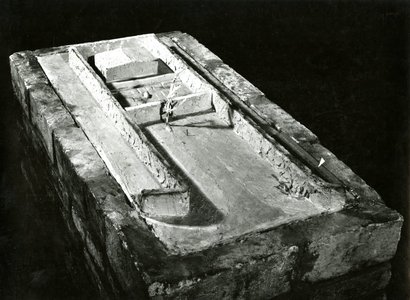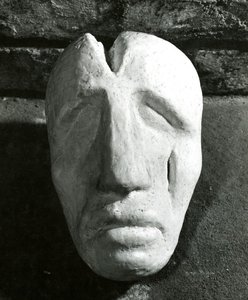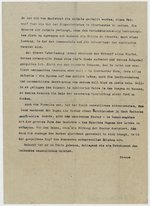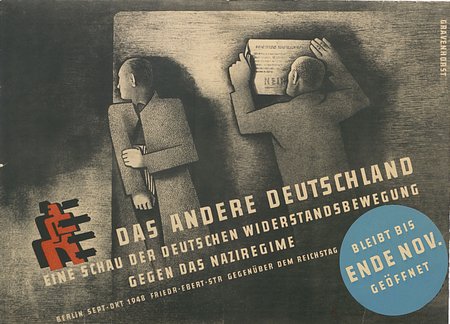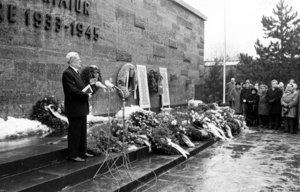From 1947, the only work performed on the former execution shed in Plötzensee was repairs. In 1948 the Berlin administration commissioned the sculptor Louise Stomps and the landscape architect Reinhold Lingner to come up with a new design for a memorial site. Lingner was the head of the city’s landscape planning and horticultural office at the time; Stomps was a freelance artist in Berlin. In June 1948 the city’s social affairs department was confident of laying the foundation stone on the Memorial Day for the Victims of Fascism in July. However, the stone was not laid, with the design merely presented to the public in the exhibition “The Other Germany” in the former Reichstag President’s Palace from September 1948.
After Berlin’s administration was split and two separate German states were founded, Reinhold Lingner worked for the East Berlin municipal administration and was involved in designing the Memorial Site for the Socialists. Louise Stomps continued working in West Berlin and took part in the competition for an international memorial in Auschwitz during the 1950s.
Reinhold Lingner’s design retained the former execution shed, framed by high prison walls. Inscribed stone plaques for the executed victims from the various nations were to be laid on the recessed paved square in front. A sculpture by Louise Stomps was to be erected in the middle of these “memorial plaques.”
Louise Stomps’ plaster sculpture for the model of the Plötzensee memorial site no longer exists. The photo shows the split skull, planned to be larger than life and erected in front of the former execution shed.
Louise Stomps on the administration’s commission
Louise Stomps’ design made no use of heroic resistance iconography. Her ideas centered instead on the pain and suffering caused to people in Plötzensee. Partly due to the intensifying Cold War and the division of Berlin into East and West, these ideas for the memorial site were also never put into practice.
This traveling exhibition on the German resistance movement was first displayed in Berlin’s Reichstag President Palace, for three months. It included the design model by Louise Stomps and Reinhold Lingner. The building opposite the Reichstag had been assigned to the exhibition organizers, the Association of Persecutees of the Nazi Regime (VVN), shortly before by the city commandant of the Soviet sector.
Harald Poelchau October 5, 1903 – April 29, 1972
Harald Poelchau studied theology and social care in the 1920s. He applied for a post as a prison chaplain in Berlin at the end of 1932, beginning work in 1933. He provided pastoral support to countless victims of the Nazi justice system, and in Plötzensee attended to hundreds of people sentenced to death. The Gestapo failed to uncover his links to the resistance or his help for persecuted people.
After 1945 he went on working in the prisons system. In 1948 Harald Poelchau was involved in the publication of letters written by resistance activists shortly before their deaths. This brought many of the men and women executed in Plötzensee to the attention of the general public. In the subsequent years, he returned to the historical site on many occasions, holding speeches in the memorial center or inviting guests to events there.

